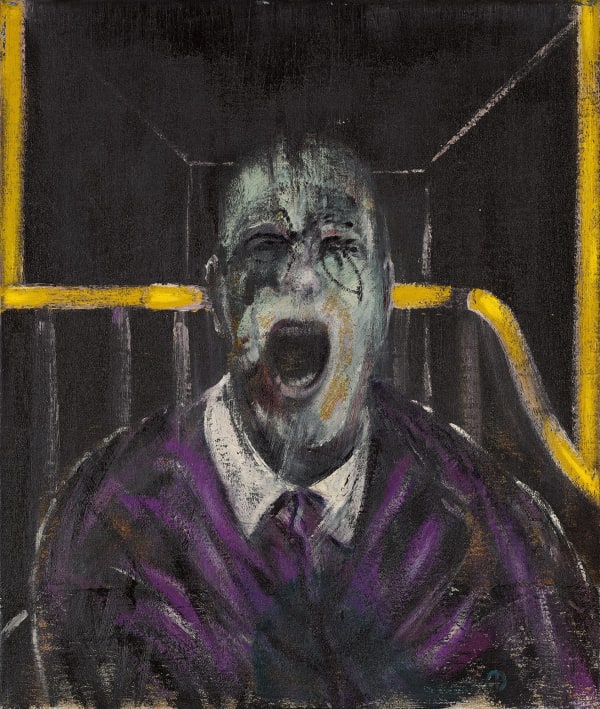-
Francis Bacon Prints For Sale.
Francis Bacon's art is a deep exploration of the human condition told through the revolutionary lens of a true genius. His distorted and contorted figures explore aspects religion, mythology & the deeply personal. Explore our latest Francis Bacon prints for sale at Guy Hepner, Bacon dealers since 2007.
Discover authentic Francis Bacon signed prints for sale below.
-
Works

Francis Bacon
Oedipe et Le Sphinx d'après Ingres , after Oedipus and the Sphinx after Ingres 1983, 1984Lithograph on Arches paper50 x 35 in
127 x 88.9 cmEdition of 150Copyright The ArtistFrancis Bacon’s Oedipus and the Sphinx After Ingres (1983) is a bold and unsettling reimagining of classical myth, refracted through the fractured lens of modern existentialism and psychological abstraction. Based...Francis Bacon’s Oedipus and the Sphinx After Ingres (1983) is a bold and unsettling reimagining of classical myth, refracted through the fractured lens of modern existentialism and psychological abstraction. Based on Jean-Auguste-Dominique Ingres’ neoclassical interpretation of the same mythological encounter, Bacon’s version discards idealized form in favour of visceral tension, emotional disfigurement, and a profound sense of metaphysical disquiet. What results is not merely a reinterpretation of a historical image, but a powerful commentary on the enduring anxieties of the human condition.
Ingres’ original depiction of Oedipus confronting the Sphinx is composed with clarity, balance, and anatomical precision—a serene moment of intellectual victory, steeped in classical ideals of rationality and composure. Bacon, by contrast, transforms this encounter into something darker and more chaotic. His Oedipus is not a poised hero solving a riddle, but a distorted, anguished figure caught in the throes of uncertainty and existential dread. The body, stretched and fragmented, is rendered with Bacon’s signature brutality, emphasizing its vulnerability and fragility rather than its heroic potential.
The Sphinx in Bacon’s version is no longer a clearly defined creature, but a haunting, ambiguous form—more suggestion than presence. Its menace is less physical and more psychological, embodying the inscrutable forces of fate, mortality, and suffering that haunt much of Bacon’s work. In place of mythic clarity, Bacon introduces ambiguity and dread, making the myth a cipher for the absurdity and unpredictability of existence itself.
The palette is characteristically restrained yet emotionally charged. Bacon employs pale, fleshy pinks, sickly beige, and muted earth tones, creating an atmosphere of physical exposure and unease. Contrasting accents of black and shimmering metallic grey slice through the canvas like wounds or ruptures, evoking armor, surgical instruments, or industrial remnants—reminders of the mechanized brutality of the modern world. These metallic intrusions reinforce a sense of dehumanization, as if the body were subject not only to metaphysical despair but also to cold, impersonal forces beyond its control.
The surrounding environment is sparse, almost barren, with faint architectural outlines that nod toward classical structures but ultimately offer no comfort or coherence. There is no setting of mythic grandeur or narrative triumph—only a dreamlike void, a space suspended between time periods and realities. This ambiguous spatial treatment heightens the sense of alienation and rootlessness, leaving Oedipus stranded in a psychological landscape where answers are elusive and suffering is inescapable.
Bacon’s departure from narrative clarity in favor of expressive abstraction is deliberate. His goal is not to retell the Oedipus myth but to deconstruct its symbolic power and reveal the raw emotional core beneath it. Where Ingres portrayed Oedipus as a rational, victorious figure, Bacon presents him as a man undone—physically and mentally—by forces that exceed reason. In this way, the image becomes a meditation on suffering, identity, and the futility of knowledge in the face of inevitable mortality.
Central to the work is the human body, rendered not as a harmonious whole but as a volatile battleground. Bacon’s figures are often reduced to fleshy fragments, distorted into grotesque configurations that blur the line between being and disintegration. In Oedipus and the Sphinx After Ingres, the body becomes a site of internal conflict, where psychological trauma manifests in violent anatomical disruption. This emphasis on corporeal distortion underscores the existential themes running through Bacon’s oeuvre—identity as unstable, the self as unknowable, and the body as the ultimate, decaying testament to human experience.
By referencing Ingres in the title, Bacon initiates a dialogue across centuries, confronting the classical ideal of perfection with the shattered reality of modern life. He takes the visual grammar of academic painting—clarity, proportion, ideal beauty—and explodes it into a visceral, contemporary language of ambiguity, anxiety, and fragmentation. The classical myth becomes a vessel for Bacon’s personal and philosophical concerns: loss, desire, death, and the impossibility of coherence in a disordered world.
In the end, Oedipus and the Sphinx After Ingres is not just a reinterpretation of a well-known image; it is a philosophical statement rendered in paint. It strips away the veneers of classicism to expose the raw nerves of the human psyche. Through distorted form, stark space, and emotionally loaded colour, Bacon compels the viewer to confront the darker truths of existence—our solitude, our suffering, and the fragile limits of our understanding.
For more information on Francis Bacon’s Oedipus and the Sphinx After Ingres or to buy Oedipus and the Sphinx After Ingres contact our galleries using the form below.Overview"The job of the artist is always to deepen the mystery".
Francis Bacon is one of the most important artists of the 20th century and post-war movements. Arguably one of the finest and most celebrated artists of his generation, Bacon holds a pivotal role in contemporary art through his revolutionary approach to his craft. One of the great explorers of the human condition Francis Bacon and his art, touch on fateful mix of mythology, religion, love and death, and document our joys, sorrows and pains perhaps better than any other artist before or since.
The imagery of Bacon is one of pure expression rejecting the prevailing artistic style of abstraction of the era, in favor of a distinctive and disturbing realism and his distorted forms convey a sense of both beauty and despair. The dichotomy in Bacon’s prints and imagery can be seen through his raw use of violent, yet delicate colors as well as the marriage he makes between the figurative and abstract. It is this soft balance between the brutal and the subtle, the violent and the soft and happiness and anguish that make Francis Bacon’s art so important and collectible. A master of painting, and known for his large scale canvases, Bacon combines seemingly disparate tectures, colours and forms to ceate a whirlwind of emotion conveying and reaching the heart of his subjective matter. Equally so Franci Bacon's print output, often as apres, lithographs or signed prints, offer his most popular subjects including Pope Francis and his famous triptychs.
Whether new to collecting Francis Bacon prints or an experienced collector, Guy Hepner can help. Since 2007 we have assisted clients across the world to buy Francis Bacon prints in confidence. Whether iconic triptych, lithographs or apres, our experienced and knowledgeable team are on hand to help you achieve your collecting goals. From our New York and London galleries, offer a wide selection of authentic Francis Bacon prints for sale.
Contact info@guyhepner.com for our latest Francis Bacon prints for sale or to buy Francis Bacon original art. News
News-

London’s Frieze Week Record Breakers
A Guide to a Blockbuster Week of Sales October 20, 2025London’s marquee auction houses just concluded a blockbuster week of contemporary art sales, coinciding with the Frieze art fair. In a series of evening auctions...Read more -

A Collector’s Guide to Francis Bacon Prints
Why Collect Bacon March 14, 2025Francis Bacon remains one of the most powerful and influential artists of the 20th century. His raw, visceral works depicting the human form in distorted,...Read more




